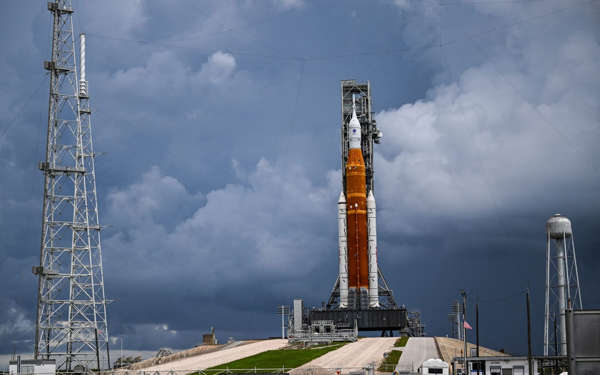On August 29th, the first Artemis I launch attempt was scrubbed due to an engine issue on one of the RS-25s engines that the launch controllers were not able to fix in time. --Mila Boyden, 7th grade
On August 29th, the first Artemis I launch attempt was scrubbed due to an engine issue on one of the RS-25s engines that the launch controllers were not able to fix in time.
Artemis I is the first step in a space exploration mission called the Artemis Mission. The goal of the Artemis Mission is to create a long lasting human presence on the Moon. NASA.gov states, “The Artemis I flight test is an uncrewed mission around the Moon that will pave the way for a crewed flight test and future human lunar exploration as part of Artemis.”
The Artemis mission is made up of 5 stages. There are 5 more that have been proposed but have yet to be official.
“Managers waved off the first launch attempt on Aug. 29 when launch controllers were unable to chill down the four RS-25 engines, with one engine showing higher temperatures than the other engines,” NASA.gov states, “Teams currently are analyzing data, updating procedures, and checking out hardware to address the issues.” This occurred 40 minutes before the scheduled launch.
The launch was moved to a little less than a week later, Saturday, September 3rd. The launch was then delayed again due to an engine link. NASA is going to try to launch the Orion spacecraft again on Monday, September 19th.
“Both Artemis 1 launch attempts have been scrubbed by technical issues. The first attempt was canceled because engineers were unable to cool one of the rocket's four core-stage RS-25 engines to a safe temperature in time for liftoff,” wrote Ben Turneron Live Science.“NASA declared that it had fixed the problem, which the agency said was caused by a faulty sensor that incorrectly reported the temperature inside the engine as being much higher, and much further from flight-ready, than it actually was. The cause of the second attempt's cancellation, a hydrogen fuel leak from one of the rocket's core-stage engines, was far more serious, requiring a rollback to fix.”
The Artemis mission is made up of 5 stages. There are 5 more that have been proposed but have yet to be official.
“Managers waved off the first launch attempt on Aug. 29 when launch controllers were unable to chill down the four RS-25 engines, with one engine showing higher temperatures than the other engines,” NASA.gov states, “Teams currently are analyzing data, updating procedures, and checking out hardware to address the issues.” This occurred 40 minutes before the scheduled launch.
The launch was moved to a little less than a week later, Saturday, September 3rd. The launch was then delayed again due to an engine link. NASA is going to try to launch the Orion spacecraft again on Monday, September 19th.
“Both Artemis 1 launch attempts have been scrubbed by technical issues. The first attempt was canceled because engineers were unable to cool one of the rocket's four core-stage RS-25 engines to a safe temperature in time for liftoff,” wrote Ben Turneron Live Science.“NASA declared that it had fixed the problem, which the agency said was caused by a faulty sensor that incorrectly reported the temperature inside the engine as being much higher, and much further from flight-ready, than it actually was. The cause of the second attempt's cancellation, a hydrogen fuel leak from one of the rocket's core-stage engines, was far more serious, requiring a rollback to fix.”
An update from NASA, posted on September 3rd, states that “Launch controllers have resumed flow of liquid hydrogen to the core stage after warming up a quick disconnect in the engine section where a hydrogen leak was detected in the cavity between the ground and flight side plates of the quick disconnect. Teams warmed up the quick disconnect to attempt to reseal it and set a proper seal.”
According to an article titled “Technical issues delay Artemis I launch. Here’s what’s comes next Engine issue, hydrogen leak force delays,” “The engines on the SLS rocket are repurposed from the space shuttles. The engine causing the trouble in particular, E2058, was used in six shuttle flights.”
NASA engineers have been trying to fix these engine problems with no success. The liquid hydrogen leak has happened multiple times and is causing big delays. NASA engineers still don’t know the cause and are currently trying to seal the leak while gathering data. They are learning from a series of trial and errors that will hopefully lead to being able to fix it in the near future.
On September 9th, the hydrogen leak was fixed. NASA engineers will be working on a tanking demonstration as soon as September 17th. This will hopefully speed up repairs and tests on the spacecraft and get it into the air shortly.
According to an article titled “Technical issues delay Artemis I launch. Here’s what’s comes next Engine issue, hydrogen leak force delays,” “The engines on the SLS rocket are repurposed from the space shuttles. The engine causing the trouble in particular, E2058, was used in six shuttle flights.”
NASA engineers have been trying to fix these engine problems with no success. The liquid hydrogen leak has happened multiple times and is causing big delays. NASA engineers still don’t know the cause and are currently trying to seal the leak while gathering data. They are learning from a series of trial and errors that will hopefully lead to being able to fix it in the near future.
On September 9th, the hydrogen leak was fixed. NASA engineers will be working on a tanking demonstration as soon as September 17th. This will hopefully speed up repairs and tests on the spacecraft and get it into the air shortly.

